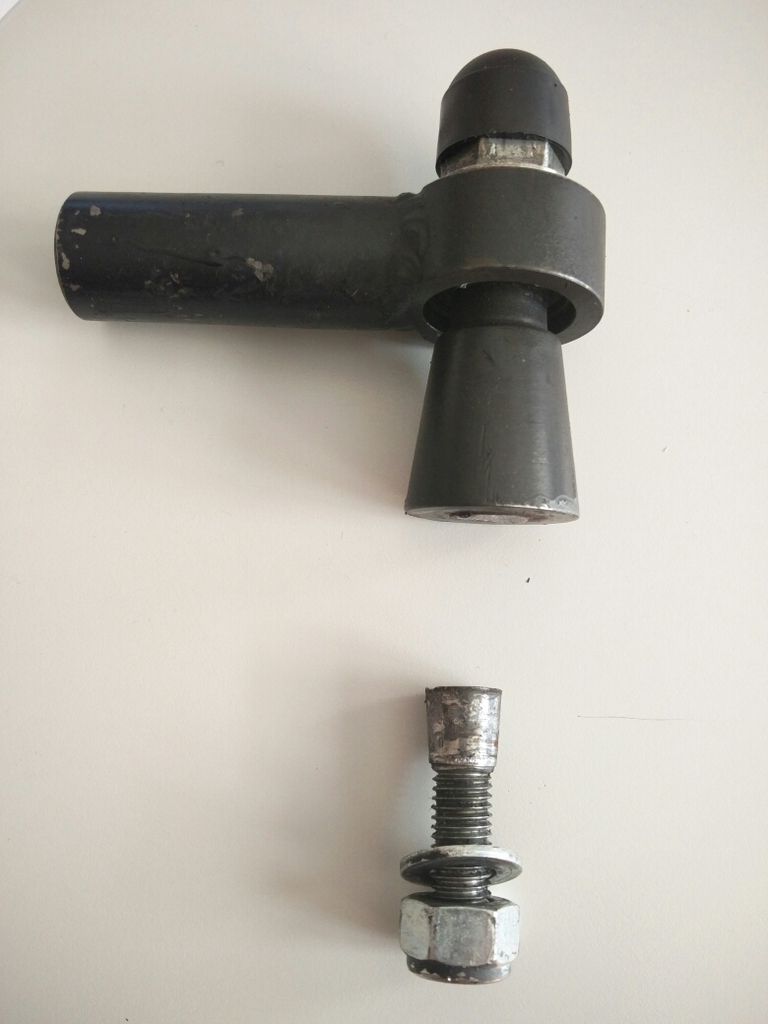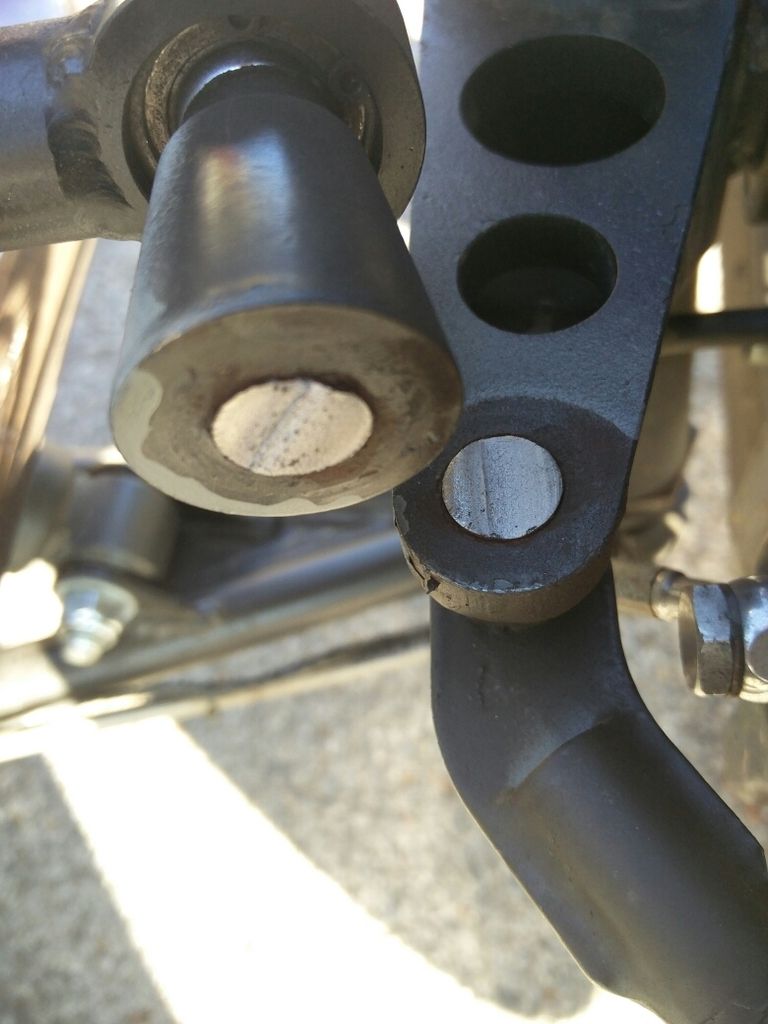|
2 members (Jo S, Moggo),
286
guests, and
37
robots. |
|
Key:
Admin,
Global Mod,
Mod
|
|
|
Forums34
Topics48,336
Posts812,905
Members9,203
| |
Most Online1,046
Aug 24th, 2023
|
|
|
|
Joined: Mar 2013
Posts: 710 Likes: 8
Talk Morgan Regular
|
OP

Talk Morgan Regular
Joined: Mar 2013
Posts: 710 Likes: 8 |
This news has been passed on to Bill at Empire, at the moment, I understand, he is trying to find out what has caused this to happen.
He has had these risers tested previously, and tells me they have resisted a lateral force of 3 tons and as this amount of leverage is unlikely in the Three Wheeler, he cannot understand why any should break. The design is a standard industry practice and has been around for years, and as long as the taper is fully fitted into the steering arm and the shoulder is in contact with the base, with the nut tight, and checked periodically, it should be fine.
However, if anyone has any doubts whatsoever about their risers, please take them off and re-fit the original track rod ends, until a solution is found.
In the meantime, I would be grateful if everone using the original risers would please pm me so we can stay in contact. To my opinion ANYONE with this risers Is risking his / her life when keep on riding with them. We all should be very happy that no serious accident has happened till so far. This can be XXXX times more dangerous as the bump steer what we had before. It don't mean I wasn't happy with the kit till so far, because the improvement in handling is enormous. But can you imagine when this breakage happens when you drive a mountain pass or it breaks and it directs you to the opposite lane where a car is coming towards you ?
|
|
|
|
|
Joined: Apr 2013
Posts: 215
L - Learner Plates On
|

L - Learner Plates On
Joined: Apr 2013
Posts: 215 |
Some details now that pictures have been posted by Laurens. It was hand torqued, checked on every ride for any play and sitting flush on the steering arm. To enable this, i had to machine the hole of the steering arm.
The riser snapped luckily at slow speed and i could brake the car to a halt without additional damage. Bill will for sure check the grade of the metal used for this riser. A straight through bolt of bigger diameter inside a riser of stainless steel would offer i think higher resistance but would require widening the steering arm hole. Additionally, i have an early 2012 car with shorter steering rods, Bill had to manufacture special end rods for my kit.
|
|
|
|
|
Joined: Oct 2013
Posts: 6,723 Likes: 2
Talk Morgan Sage
|

Talk Morgan Sage
Joined: Oct 2013
Posts: 6,723 Likes: 2 |
  Photo's sorted at least..
Steve
|
|
|
|
|
Joined: Jun 2015
Posts: 572 Likes: 2
Talk Morgan Regular
|

Talk Morgan Regular
Joined: Jun 2015
Posts: 572 Likes: 2 |
That fracture from what I can see by enlarging the photo bucket image, looks crystalline to me. That would point to a fatigue failure. My guess is that stress multiplication at that point may be occurring and maybe the taper should have had a radiused shoulder where it meets the conical riser, rather than what looks like a right angle. I would also wonder about what sort of the heat treatment the whole thing had, if any and what steel was used. For something like this, aircraft spec should apply where the fatigue resistance is of the order of 10⁷ load cycles and in order to test this, ultrasonic stress testing would have to be done. This might make the whole thing uneconomic.
Many thanks for posting this. It has made me decide to stick with the bump steer on my 2012 for the time being. I don't particularly like the feel of the comfort kit as it seems to introduce more understeer.
|
|
|
|
|
Joined: Oct 2015
Posts: 25
Just Getting Started
|

Just Getting Started
Joined: Oct 2015
Posts: 25 |
What is the diameter of the bolt at the failure point? It's hard to gauge the size in the photos.
The taper fit should keep the bolt from wallowing in the arm, but any load support provided by the shoulder would be lost if the taper locked in first. If the shoulder makes full contact before the taper locks in, the benefits of the taper are lost. In other words, a proper fit would require absolute precision on both the bolt and the steering arm, something that seems almost impossible in a production situation. Once it is assembled, visual inspection isn't very useful, because the failure point will be hidden from view.
I'm not a metallurgist, but my limited experience with stainless hardware has been that the threads tend to gall and seize when torque is applied, and this causes the bolt to fail when disassembly is attempted.
Bill in FtL
|
|
|
|
|
Joined: Aug 2012
Posts: 2,356 Likes: 2
Talk Morgan Expert
|

Talk Morgan Expert
Joined: Aug 2012
Posts: 2,356 Likes: 2 |
|
|
|
|
|
Joined: Jan 2013
Posts: 400
Learner Plates Off!
|

Learner Plates Off!
Joined: Jan 2013
Posts: 400 |
Maybe it is just a psychological gloss-over on my part, as I love my Empire kit, but there is quite a bit of goods on both ends of the break.
Was it really flush?
Even a millimeter of space would allow movement and eventually fatigue.
(Mind you, like I said last time - I'm not a metal worker/metalurgist.)
M3W, now!!!
|
|
|
|
|
Joined: Jan 2014
Posts: 1,075
Has a lot to Say!
|

Has a lot to Say!
Joined: Jan 2014
Posts: 1,075 |
What is the diameter of the bolt at the failure point? It's hard to gauge the size in the photos.
The taper fit should keep the bolt from wallowing in the arm, but any load support provided by the shoulder would be lost if the taper locked in first. If the shoulder makes full contact before the taper locks in, the benefits of the taper are lost. In other words, a proper fit would require absolute precision on both the bolt and the steering arm, something that seems almost impossible in a production situation. Once it is assembled, visual inspection isn't very useful, because the failure point will be hidden from view.
I'm not a metallurgist, but my limited experience with stainless hardware has been that the threads tend to gall and seize when torque is applied, and this causes the bolt to fail when disassembly is attempted.
Bill in FtL Bill, my thoughts too. If the taper hits first there will be a slight gap under the upper support and likewise if the taper is not met. My thoughts on this would be, just like most heim joint applications, a through bolt, possibly an Allen grade 8. I would use a bolt through the heim joint, through the collar support extension and then through the steering arm and fender bracket. Based on the taper in the steering arm, I would turn down a tapered sleeve that would be bolt size ID and then fit the taper. The bolt would just run through the taper sleeve. The entire assembly could then be torqued down very tightly. Streetrod, off-road vehicles all use heim joints on the steering and they are all through bolted to the steering arms. Didn't the "comfort kit" from M3W just use a through bolt in their kit even though the steering arm has the taper? I've not heard of any of them breaking off.
Dan
|
|
|
|
|
Joined: May 2014
Posts: 360
Learner Plates Off!
|

Learner Plates Off!
Joined: May 2014
Posts: 360 |
Yes Dan, you are quite correct.
The comfort kit uses an allen bolt that goes right through the whole assembly and makes no use of the taper socket in the original steering arm.
|
|
|
|
|
Joined: Jun 2015
Posts: 572 Likes: 2
Talk Morgan Regular
|

Talk Morgan Regular
Joined: Jun 2015
Posts: 572 Likes: 2 |
Yes Dan, you are quite correct.
The comfort kit uses an allen bolt that goes right through the whole assembly and makes no use of the taper socket in the original steering arm. If you are using an Hex socket screw you can then opt to use the equivalent of A102 aircraft spec bolts in ultra high tensile steel. A102 is a hex head UNC bolt and I forget what the equivalent spec metric hex socket head reference is (it might be DIN-912) but I use Unbrako series 1960 Alloy steel hex socket screws on my 911 RSR rally car. These are extremely fatigue resistant and it is standard practice to use these for example on wishbone bolts on competition cars, where they carry high shear loads. You used to have to buy these from aircraft fixings suppliers with lots of paperwork and they were very expensive due to all the tracking paperwork. You can now buy them tracking free for non-aviation use, which makes them much cheaper, from companies like socketscrews.co.uk
|
|
|
|
|



